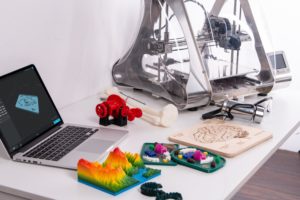3D printing can be a great way to quickly manufacture custom tools and equipment, prototype new designs and create a huge variety of different objects. However, despite the power of technology and the advantages it has over other manufacturing methods, 3D printing can still create a significant amount of waste.
Luckily, there are printing strategies you can use to make your 3D-printing less wasteful and more eco-friendly.
Here are some 3D printing techniques that you can use to reduce printer waste and make your 3D printing more environmentally friendly.
How 3D Printing Can Create Pollution
While some 3D printing filaments are biodegradable, many popular filament types — like ABS, PET and nylon filaments — aren’t. If objects created with these filaments aren’t recycled, they’ll be left to accumulate in landfills or the environment. Failed prints, outdated prototypes and impulsively made unnecessary 3D objects can easily contribute to pollution, if not printed with the right material or recycled afterward.
Worse, nearly all biodegradable filaments won’t break down except under special conditions. The most popular 3D printing material, PLA filament, is biodegradable but won’t decompose if just left outside — instead, it needs certain humidity and temperature levels, plus the presence of special bacteria to actually break down. Objects created with biodegradable filament can still contribute to pollution if not recycled, depending on the material they’re made out of.
Avoiding Waste With 3D Printing
Luckily, there are a few different strategies you can use to reduce the amount of waste your printing produces.
You can start by using sustainable 3D printing filaments. The cheapest or most flexible option available isn’t always guaranteed to be environmentally friendly, but there are sustainable options out there you can use to make your printing more eco-friendly — like hemp-derived filaments, which typically contains only bioderived materials and could be biodegradable. With these biodegradable filaments, it’s possible to prototype or experiment with one-off projects without having to worry about where the plastic will eventually end up.
However, fully biodegradable filaments won’t be suitable for every project. Even in cases like these, however, you can still use filaments that are more sustainable than others. There are a few different companies that create 3D printing filament from recyclable materials — if the printing filaments they have available are suitable for your project, these can be a great way to reduce the resource consumption of your 3D printing and make it a little more sustainable. In some cases, the recycling process is completely powered by renewable energy — making the filament an even more sustainable option.
You can also use other waste-minimizing strategies — like using water-based paints and powering your 3D printing with renewable energy sources when possible — to further reduce any of the pollution and waste that may be created by your printing.
Reducing 3D Printing Pollution
3D printing can be a powerful tool — however, without the right precautions, it can also be harmful to the environment. The technology uses significant amounts of energy, and if not powered by renewables, it will add to your carbon footprint. Objects printed from the wrong filaments — including some marketed as biodegradable — won’t break down and will accumulate in the environment.
Fortunately, there are ways to reduce the pollution created by 3D printing. For example, you can use specialized filaments to create fully biodegradable objects or switch to renewable energy sources to help cut down on waste.
Join the discussion of this and other 3D printing topics at 3DPrintBoard.com.
Subscribe to Our Email Newsletter
Stay up-to-date on all the latest news from the 3D printing industry and receive information and offers from third party vendors.
You May Also Like
Wisconsin’s Evology Adds Digital Sheet Forming to Service Roster
Evology, a service bureau based in Wisconsin and specializing in serving strategic sectors like aerospace and defense, has added digital sheet forming (DSF) to its repertoire of manufacturing capabilities. Evology...
Boring Company Alum Score $9M for Advanced Composites Manufacturing
Layup Parts, a Huntington Beach, CA-based startup specializing in on-demand manufacturing of parts made from composites, has received $9 million in its latest financing round. Founders Fund, the VC firm...
Industrial Giant Ingersoll Rand Leads $19M Round Backing Inkbit’s AI-Driven 3D Printing
Inkbit, the Massachusetts-based original equipment manufacturer (OEM) of multi-material, AI-integrated 3D printers, has closed a $19 million financing round. Ingersoll Rand, a US giant in the industrial equipment sector, led...
3YOURMIND & Nigerian Oilfield Services Firm RusselSmith Team Up on 3D Printed Part Inventory
3YOURMIND, the German and U.S. software services provider specializing in digital inventory platforms for additive manufacturing (AM), has partnered with Nigerian oilfield services firm RusselSmith to digitize spare part files...


































